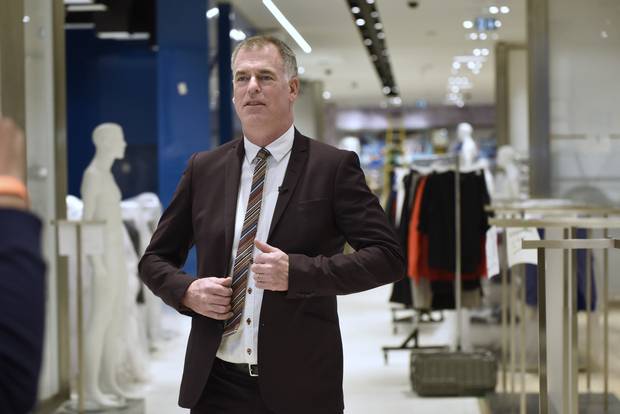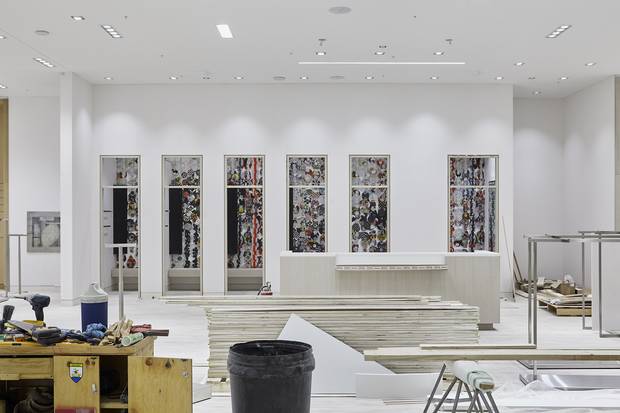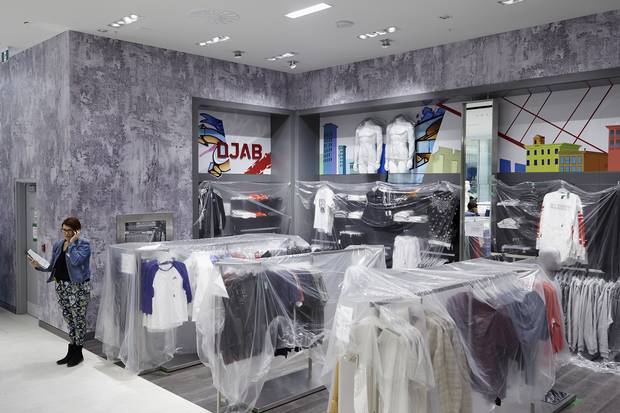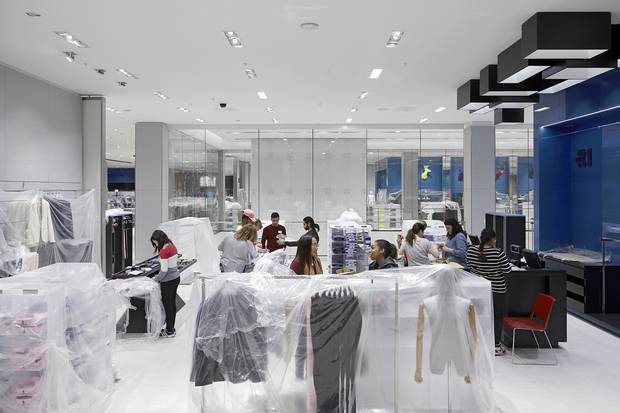On the day I meet Peter Simons, it's late November—for retailers, the most wonderful time of the year. But this year, not so much. Sears Canada has just announced it will shed yet more real estate in its struggle to stay solvent. Mexx Canada is preparing to file for bankruptcy, joining the long line of Canadian chains that have closed their doors in recent years. And it's shaping up to be the most dismal holiday shopping season since 2010, with clothing sales down 3.6% over a year earlier.
Yet here is Peter Simons, overseeing construction of the newest branch of his lavish department store, La Maison Simons.
It's four months before the Quebec City-based retailer's outpost at Mississauga's Square One Shopping Centre is scheduled to open, and construction is four weeks behind. The guts of the 113,000-square-foot space are just starting to take shape, with no hint yet of the architectural flair for which Simons is renowned. Dozens of dust-covered workers go about their business—smoothing cement onto floors, taping, sanding, painting—all while trying to ignore the six-foot-four boss in their midst.

Construction at the 113,000-square foot Mississauga location took three months to complete.
JEREMY KOHM/FOR THE GLOBE AND MAIL
The Square One store in Mississauga is Simons’ first foray into the Ontario market.
FRED LUM/THE GLOBE AND MAIL
Peter, the chain's co-owner and CEO, seems anxious and hard-edged as he fires questions at Andi Duns, a petite Vancouverite who oversees the project for contractor Govan Brown. It's a dramatic shift from the charming, almost earnest man I'd interviewed earlier in the day in the offices of the mall's manager, Oxford Properties. When are the tiles and lights going in, Peter wants to know, arms crossed over his neon safety vest and camel coat. When can the millworkers get in to install the custom-built walls? What about the security cameras and wiring? He bounces from English to twangy Québécois French to consult his head of store design, Julie Bélanger, who stands beside him calmly tapping on her iPad.
Simons has a lot at stake—both the brand and the man. Simons the brand is the oldest privately owned family business in the country. Simons the man is, along with younger brother Richard, the fifth generation to run the shop. Until the pair took over from their father in the mid-1990s, Simons had just three locations, all in Quebec City. Now the company is in the midst of a $200-million westward expansion that began in 2012, when it opened its first store outside its home province. Square One will be its third.
"It's a big risk," admits Peter. "We're trying to do something no one's done in 50 or 60 years—build a national brand that is meaningful and resonates." Harry Rosen and Holt Renfrew are the only two names he can come up with that offer a decent comparison.
Peter says the build-out "is more challenging than I suspected." But he's betting that, even in the e-commerce era, shoppers are still willing to venture out to bricks-and-mortar stores that serve up a bit of wow along with the chic sweaters and skinny jeans. Which is why Simons is spending big to open stores brightened by enthusiastic salespeople and art installations by the likes of Douglas Coupland and Philip Beesley.
Even as invaders like Nordstrom and Saks Fifth Avenue throw open the doors on highly anticipated new stores across Canada, Simons believes it has an edge with its mix: pricey designer labels alongside a longstanding roster of affordable store-brand options. And while its name recognition is close to nil outside La Belle Province, Simons still has a home-grown advantage.
Indeed, you can't get much more Canadian than the Simons brothers, with their Scottish roots and French accents. Their philosophy—and, they believe, a competitive edge—is partly about old-school paternalistic capitalism and partly about 21st-century social licence. Get him talking, and Peter Simons turns out to be the Bernie Sanders of Canadian business.
VIDEO From construction to completion: Simons Mississauga store comes to life
0:32
The store's history dates back to 1840, when Peter's great-great-grandfather, John, the son of a Scottish immigrant, left the family farm to open a dry-goods store in Quebec City. He was just 17. John imported most of his stock from Europe; as legend has it, he sailed across the Atlantic 72 times over the course of three or so decades before handing the store to his son. This was hardly an era of fast fashion: John would put in his orders—for
textiles, buttons, linens, lace—and receive the shipments a year later.
"He laid the groundwork for the DNA of the company," says Peter, who is 51. "It was easy in a little town like Quebec to be closed in on yourself and think it was the centre of the universe. And there he was, trying to find the best things around the world and bring them back to customers in Quebec."
Simons stuck to the same formula even after Peter and Richard's dad took over in the 1950s and converted the store into a specialty fashion boutique. Donald travelled constantly on overseas buying expeditions. When he was home, Peter says his father rarely talked shop, and the four Simons kids spent little time at the foundation store on Côte de la Fabrique. (An exception was at Christmas, when Donald would close up and let the brood run wild while he worked and his wife, Barbara, did her holiday shopping. "I remember lifting up all the cash registers, hoping someone had left a penny underneath," says Peter.)
Like many scions, Peter and Richard learned the family business almost by osmosis. "We grew up not spoiled, but with nice things around us," says Peter. Donald loved modern art and architecture and beautiful clothes; yet both boys admit to being more jeans-and-flannel kids.
There was never any overt pressure to take over the business, and Peter initially had no intention of doing so. For a year, he studied engineering and played basketball at Carleton University, and then switched to business administration at Western University. When he graduated in 1987, he had a couple of job offers—including one from his father. There were caveats, however: "It was clearly going to be a meritocracy, and he established his right to fire me if I was incompetent. He'd always taught us that the family exists for the company and not vice versa. Four generations had spent their lives building this thing. I respected that."
Peter accepted the offer and started as a buyer of women's gloves and skiwear, and then moved on to knitwear, sportswear, and even lingerie. "I did it all," he says.
Richard says Peter was the natural successor to their father. "Peter's a great speaker," says Richard. "He inspires people. It's not just about making money. It's about building a quality business, not just a bigger business."

Co-owner and CEO Peter Simons.
FRED LUM/THE GLOBE AND MAIL
Although Donald kept "threatening" to retire, Peter says he gave up believing his father would ever clear out. "When you start working, you just want to get the old guys out," he says. "Then you grow up and realize that if you can find a balance between the energy of the young and the experience of the older people—if both generations respect what each brings to the table—there's no need to bring this abrupt end to it."
Donald, who's now 87, was still coming into the office in the late 1990s, when Peter and Richard began to plot expansion beyond Quebec City. Donald was "constructively critical" of the plan, which saw Simons open stores in both Sherbrooke and Montreal in 1999. It's not hard to see why Donald was worried. This was, after all, also the year that brought the bankruptcy of another family-run department store chain, Eaton's (which, incidentally, was founded nearly three decades after Simons).
"My father always had his feet on the ground," says Peter, "and he just felt we were a small, private firm, and it was a big, dangerous world out there."

It took more than a century for Simons to add a second location – and that was just across town in Quebec City. Now it’s blitzing every major market west of its Quebec base.
Despite the patriarch's reservations, Simons continued the expansion. Today, it has 12 stores and annual revenue of around $400 million (which is as specific as Peter will get when it comes to doling out financial information). That's small compared with rival Hudson's Bay Co.—which has 460 stores worldwide under 10 brands, including Saks—or Seattle-based Nordstrom, which will soon have six Canadian stores in addition to more than 300 in the United States. And those are just the players Simons competes against in the physical realm; online, its list of rivals is nearly endless. "We get into the ring every day with massive global corporations—very few of them Canadian anymore—and they have certain advantages," Peter says mildly.
Chief among them: scale and the buying power that comes with it. Peter has never been a big believer in "scale as a strategy"—and you have only to consider Target's disastrous Canadian implosion to see there's some wisdom there. But he and Richard realized early on that they needed a bit more heft, if only to make dealing with Simons worthwhile for suppliers and designers. Even the launch of the company's e-commerce store in 2010 pointed to adding more bricks-and-mortar locations as showcases whose sales are consummated online (digital sales are about a tenth of Simons's total). The plan is to reach 17 stores, in all of Canada's major markets, by 2019.
That's not a cheap endeavour, particularly when Simons, as a private company, cannot tap equity markets to pay for it. Peter says his company has solid backing from the Bank of Montreal (and has had since 1847; it's BMO's oldest client) and, relatively recently, from Banque Nationale. Still, he's staking his family's fortune on making this expansion pay off, even when high-end is a tight corner.
When you vet Simons's plan with four retail analysts, as I did, nary a one of them has a bad word to say. Even the CEO of Harry Rosen Inc. is a fan. Larry Rosen has a special affinity for anyone operating a private family firm in Canada, and he's rooting for Simons to succeed (particularly since, in his view, Simons is not a direct competitor).
To gird itself for the arrival of Saks and Nordstrom, Rosen says his own chain spent more than $100 million over several years to upgrade its 17 stores. "Relative to the size of our company, we've spent a ton," says Rosen, who took over from his father, Harry, in 1997. "Putting out a great retail offering is capital-intense. Building stores is expensive. Retail systems are expensive. Investments in e-commerce are expensive. You've got to be very well-financed."
Simons is in much the same position as Harry Rosen was when it began to expand outside its Toronto home base in the early 1980s. "We didn't walk into these markets and become No. 1 overnight," says Rosen. And Simons shouldn't expect to, either. "The advice I'd give Peter is to be focused and to recognize that every market in Canada is different. You've got to learn the customer and earn their loyalty in every city."
Richard shrugs off this concern. "It's the same story as when we went from Quebec City to Montreal," he says confidently. "Only maybe 20% of the population had heard of Simons. Now we have close to 100% penetration."
If Simons is smart about it, it will leverage a history that is deep—175 years—if not (yet) nationwide. "A company like Canadian Tire has proven that you can appeal to Canadians by being Canadian," says Maureen Atkinson, a consultant with J.C. Williams Group in Toronto. "Obviously, Simons has to do everything else, but it can play up its heritage."
The past five years have not been kind to Canadian retail. Zellers, Smart Set, Jacob, Future Shop—all gone. Danier is in bankruptcy protection, Sears Canada is hanging by a polyester thread, and the Target debacle left a vast acreage of retail space empty. All the new blood is in the luxury segment, but there are only so many of those shoppers to go around—and the broad middle market seems in no haste to join them.
The juxtaposition of events has left mall owners scrambling to find anchor retailers that can draw a critical mass of shoppers through their doors. But then, it's not a new problem. Five years ago, Triple Five Group—umbrella company of the Edmonton-based Ghermezian clan—launched a $100-million renovation of the West Edmonton Mall to give the mecca of kitsch more upscale appeal. The search for an anchor pointed to Simons.
"We were aware that Simons was both popular and unlike any other fashion retailer in Quebec," says the mall's president, David Ghermezian. "We didn't truly appreciate the extent of their popularity until we visited and spent a significant amount of time in their stores." Ghermezian lauds Peter as a "hands-on operator" and goes so far as to call Simons "revolutionary" in everything from merchandising to design to customer service.
Peter says there was instant chemistry between the two families. "They just sort of understood what we were trying to do," he says. "Maybe in a family company you can just say, 'Ah, screw it. I don't have to work with people that are a pain in the ass.' You can be a little choosier."
Indeed, in his mind, Simons's status as a private company, unhampered by earnings-obsessed analysts and shareholders, is perhaps its greatest weapon. It's doubtful, for instance, that the board of a publicly traded corporation would support Peter's lavish spending on high design.
As a boy, he dreamed of being an architect and might have pursued the idea—"If I'd had any skill or talent." Still, that original appetite permeates each Simons store. No two are alike. In downtown Montreal, a four-tonne, $300,000 glass sculpture by Guido Molinari (Donald Simons's favourite artist) hangs from the ceiling. When the Côte de la Fabrique store was renovated in 2005, Peter bought a 19th-century Italian glass-mosaic cupola in Paris and had it installed in the men's department. The Sherbrooke store—overlooking a vast mall parking lot—riffs on Frank Gehry's undulating Guggenheim Museum in Bilbao, Spain.
Nowhere has Simons spent more than at the West Edmonton location, which opened in 2012. The facade is covered with rotating titanium blades; inside, an interactive sculpture by architect Philip Beesley lights up in response to shoppers waving below. The project cost Simons more than $40 million, with the Ghermezians chipping in another $10 million. "We went way overboard on the architecture," Peter admits.
But there's method here, he reiterates; the idea is that a trip to Simons ought to be about more than picking up a $10 T-shirt or $60 blazer. It should be about art and community and beauty.
"If people don't appreciate it," Peter says a little glumly, "then we're dead."

Each department has its own space and design esthetic, such as these whimsical fitting rooms for the Icône department.
JEREMY KOHM/FOR THE GLOBE AND MAIL
Squeeze into the flagship Simons store on Montreal's Rue Ste-Catherine on an average Saturday and it appears the shopping-as-experience gambit has been a resounding success. "In the rest of the retail world, it's all about, how fast can we get them in and out, and how efficient is the store?" Atkinson observes. "Simons seems to understand they're in the experience business."
But while the splashy design might be enough to get newbies through the door, it's the clothing that keeps them coming back. A good chunk of Simons's business is on the high end, and it has major cred in international fashion circles. It's the only Canadian chain that carries Vivienne Westwood, for instance. You'll also find $1,850 Versace sheaths, $700 Alexander McQueen shoes and $400 Nina Ricci scarves on Simons's racks.
But unlike chains such as Holt and Saks—or Les Ailes de la Mode, which made an ill-fated foray outside its Quebec base 15 years ago—Simons is not peddling an exclusively luxury assortment. Rather, its strength lies in designs for the masses: eight in-house labels, some of them launched by Donald back in the 1960s. The popular girls' line, Twik, was inspired by the likes of Twiggy and Brigitte Bardot. Contemporaine and Icône cater to women. Le 31, for men, plays on the French equivalent of "dress to the nines"— se mettre sur son 31. There's even a home decor line called Simons Maison. Together, the in-house lines account for up to half of Simons's inventory, depending on the department. This, says retail consultant Craig Patterson, is its genius: "Simons controls the margins, the pricing and the sourcing, and no one else carries it."
The assortment also draws a wide range of customers—men, women, teens, seniors—though each label has a distinct area in-store, so the 50-something financier isn't trying on suits next to a teenage skate punk buying artfully torn jeans. (At Square One, the space dedicated to the boys' streetwear line Djab has jokey porta-potty fitting rooms.)

The assortment of clothes at Simons draws a wide range of customers, though each label has a distinct area in-store.
JEREMY KOHM/FOR THE GLOBE AND MAIL
Curator-in-chief is Richard Simons. As vice-president of women's merchandising, he oversees 50 buyers, plus 50 in-house designers, graphic artists and other artisans. It is no small advantage that he hails from a province that is often a half-year ahead of major fashion centres like New York. Still, each year, he attends 100 fashion shows—Paris, Milan, New York, London—and meets hundreds of designers, searching for lines to add to Simons's collection. From that source, alongside the output of the in-house team, "We're creating an assortment, like a menu in a restaurant," says Richard. "You should be able to walk through the store, even just on your way to the bus station, and learn something about fashion."
When Simons opened its doors at the West Edmonton Mall in 2012, Patterson, then an Edmonton resident, thought it might be a little too fashion-forward for Alberta. But he says the store has been jammed since it opened. For the first two years, at least, Peter says the location generated sales per square foot of $600—robust by industry standards. He says the store has seen positive growth this year too, even as Alberta's economy flounders; growth across the chain has been double-digit. "I very much like our positioning in terms of offering exceptional value as opposed to pure luxury," says Peter. "It certainly has been resonating." (With an assist from the dollar, perhaps. With the loonie hovering around 71 cents U.S., "that shopping trip to New York City just became 37% more expensive, and that's a big number on a $5,000 suit," says Jim Danahy, a retail consultant with CustomerLab in Toronto.)
It’s not commission-based; it’s more a values-based organization. It’s not, ‘Yeah, yeah, that looks great on you.’ Let’s just take care of people.
Peter Simons
You won’t find pushy salespeople prowling the aisles at Simons, however. It’s renowned across the industry for its top-notch service. “I’m hoping we can translate the fact that we’re private into exceptional Canadian service,” says Peter. “It’s not commission-based; it’s more a values-based organization. It’s not, ‘Yeah, yeah, that looks great on you.’ Let’s just take care of people.”
Not coincidentally, Simons is also lauded for paying well above minimum wage (in 2012, it raised salaries by more than 20%) and for providing generous benefits. That’s a legacy of Donald Simons, who taught his children to treat people, especially employees, fairly. Says Peter, “My father was demanding but respected, and he understood he had a role to play in society.”

Simon’s team of merchandisers stocks shelves and trains some of the 200-plus cashiers and salespeople who will work at the Mississauga location.
JEREMY KOHM/FOR THE GLOBE AND MAIL
The larger Simons gets, the more difficult it is to cling to the values it has held close through the generations. With more than 3,000 employees scattered across 5,000 kilometres, it’s been a long time since Peter could visit each store once a week and know every worker’s name. And he can no longer order stock “by gut.” Six years ago, the company overhauled its logistics software and it is now beta-testing a new algorithm developed by “this kid…this Russian mathematician.” It’s meant to make sense of all the data Simons collects on customers’ purchases and to use it to get the right stock to the right store at the right time.
But there are some things Peter refuses to change. All of Simons’s merchandise, for both online and bricks-and-mortar sales, will continue to ship from its original facility in Quebec City. “Our warehouse guys are super-duper good,” he says, adding that many of them have worked for Simons for decades.
Here—employee retention—and everywhere, seemingly, it comes down to “social licence,” a theme Peter returns to again and again. “When you have people in the newspaper telling their shareholders they’re so proud they paid 2% income tax last year, that’s a crock of shit,” he declares. “It’s wrong. It’s just wrong.”
“I’m not stupid—I could transfer all our profits offshore,” he continues. “I just see this breakdown in the fiscal pact, and it concerns me. If 50% of global capital moves through tax havens, how are you going to pay for your parents later on? I’m a free trader, but there has to be equity.”
He is convinced that, otherwise, the 99% are going to start pushing back. “Revolutions have a way of creeping up on you,” he says. “One day you’re telling them to eat cake; the next day they’re chopping your head off.”
Both he and Richard know that upheavals are common at family-controlled companies, too. Though both brothers would like to see a sixth generation of Simons run the business—they have five children between them—they wouldn’t hesitate to bring in outside management if the kids weren’t both eager and ready. “They’ll have to prove themselves,” says Richard. “There’s nobody that can’t be fired. I think that’s important to how our employees perceive us.”
“Businesses like ours are fuelled by energy and passion,” Peter adds. “It’s not about making money for the next quarter—it’s about your name on the door. My brother and I want to be proud of what we do, and that leads us to a whole bunch of choices about what role we take in society and how the company weaves itself into the social fabric.
“And there’s a new age coming. So how do we fit into that?”